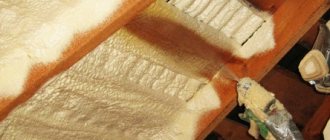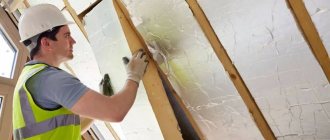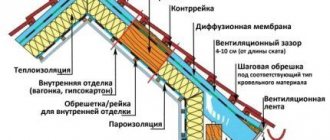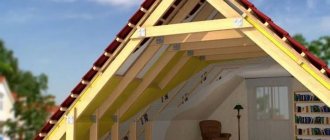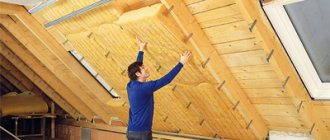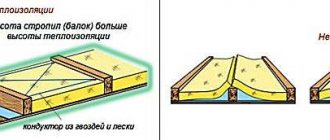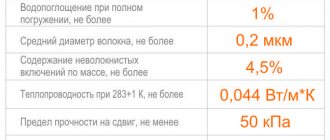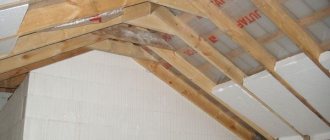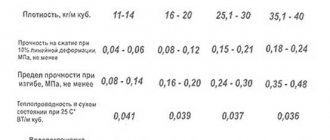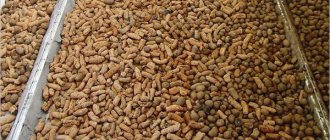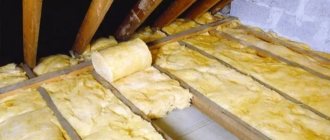When choosing roofing material for his home, the developer is guided, first of all, by his financial capabilities. Taking into account this fact and the type of roof, one or another material is selected. The comfort and coziness in the house, as well as the service life of the roofing material, depend on how competently and efficiently the installation work and roof insulation are carried out.
There are two types of corrugated sheeting: wall and roofing. Wall corrugated sheeting, as a rule, has a lower wave height.
Corrugated sheeting is one of the inexpensive but aesthetic roofing materials. This material is a corrugated or ribbed (trapezoidal) galvanized sheet obtained by cold rolling. A roof made of corrugated sheets has an unlimited service life, however, like all metals, this roofing material has very low heat-insulating properties. In other words, a roof made of corrugated sheets requires particularly careful insulation.
The need for roof insulation
It is unlikely that anyone will insulate the attic roof. The cold attic in private houses of old traditional construction serves as a storage place for things that have served their time.
A complex insulated roofing assembly can be constructed by a person who, with the help of an attic, intends to significantly increase the volume of a residential location. That is, he creates additional living space under the roof of his house.
Its construction will require different technological content. The traditional roofing assembly has been thoroughly modernized, introducing into its structure new elements necessary for the construction and long-term functioning of the insulating layer.
The modern attic usually serves as the main sleeping area for family members. The premises are equipped with all types of plumbing and sewer systems:
- showers;
- toilets;
- natural and forced air ventilation;
- electricity.
All this requires a certain positive temperature for its normal functioning.
An insulated roof covered with corrugated sheets, metal tiles, painted reeds and other roofing materials can create a favorable operating conditions.
Waterproofing cold roofs - is it necessary?
The space under a cold-type roof is not heated, but the temperature inside is always different from the outside.
For this reason, condensation collects at the bottom of the profiled sheets. Therefore, the answer to the question: “When a cold roof is built, is waterproofing necessary?” unambiguous Of course it is needed. Properly installed waterproofing on the roof under the corrugated sheeting will prevent moisture from entering the under-roof space. This layer will prevent wet fumes from reaching the wooden elements of the rafter system and other parts of the roof structure. The waterproofing is laid on top of the rafters and then secured with a counter-lattice. Next, install the sheathing and corrugated sheet.
When the waterproofing layer does not prevent steam from escaping outside, then there is no need to install a vapor barrier for a cold roof. Having risen upward, water vapor gets through the film under the corrugated sheet and dries out in that place due to the movement of air currents. In this case, roofing felt, polypropylene, glassine and polyethylene are not suitable. For a cold roof, experts recommend using a non-woven vapor-permeable membrane.
What thermal insulation materials are needed to insulate a corrugated roof?
Private housing construction has received an exclusive direction for the manufacture of insulated attic roofs. From the various methods of installing a warm roof covering, the best option has been identified, which has become the dominant element today.
Integrated into the warm layer:
- lining or dry plaster;
- a thin layer of vapor barrier is placed on the internal finishing material;
- the space between the rafters is filled with insulation;
- then they are completely covered with a hydrobarrier (roofing felt, a special synthetic film);
- they are sewn over the top with lathing in increments of 1-4 cm. To organize the ventilation space, counter-lattice is installed in increments of 40-50 centimeters.
Roof insulation
Corrugated sheeting is attached to the sheathing. With a pitch of 35 centimeters, there is a guarantee that the wind will not “lift” the profiled sheets.
Important
- Use environmentally friendly thermal insulation materials.
- With low thermal conductivity.
- Does not form unpleasant odors
What to prepare before starting work
Insulation installation work
A classic of the genre - marking corrugated sheets using twine and chalk
Electric scissors – will provide high productivity
Why is ventilation necessary?
Warm air rising from a heated room contributes to the accumulation of condensation in the under-roof space, as a result of which the house begins to become damp. The consequences of this may be:
- the appearance of mold and mildew;
- rust on metal parts;
- damage to the thermal insulation layer;
- rapid wear of supporting structures;
- overheating of the roof from the inside , which in winter contributes to the melting of snow and the formation of icicles on the eaves.
Cornice
The arrangement of the cornice can be carried out using plastic air-conducting grilles , which are mounted in the lower cornice boards or a special “breathing” material placed between the beginning of the roof and the walls. You can also simply leave an air gap between the cornice and the walls of the house, but it should be borne in mind that this method reduces the thermal insulation characteristics of the building.
Basic requirements for materials when installing a warm roof made of corrugated sheets
When insulating a roof, you should use materials with the following characteristics that have acceptable performance:
- by thermal conductivity;
- by hygroscopicity;
- by vapor permeability;
- by elasticity;
- by compressive strength;
- by elasticity.
The installation of a warm roof requires high-quality materials. It refers to
- vapor barriers
- hydrobarrier
- insulation
- corrugated sheets.
A warm roof includes auxiliary materials: for steam removal, waterproofing devices.
Today, construction trade enterprises will offer the developer a wide range of goods, both domestic and imported. Usually these are polyethylene films with the necessary performance characteristics. Inexpensive but functional.
Steam-hydro-windproofing materials
Many people still use roofing felt as a water barrier. Cardboard impregnated with bitumen cannot be a suitable location for harmful bacteria and fungal colonies that can turn wooden components and elements of the roofing system into dust.
As for insulation, all kinds of materials of organic and chemical origin are used:
- mineral wool
- stone wool
- bulk materials subject to packaging
- penoplex
- Styrofoam
- other
Thermal insulation materials
Installation
Depending on the selected material, the installation technology will be different. However, expanded polystyrene boards are laid between the rafters or simply glued to the surface of the ceiling with glue, which does not cause difficulties and does not require detailed explanation. Polyurethane foam is sprayed by specialists using special sprayers and you don’t have to do anything yourself at all.
You will only have to figure out the technology for laying mineral wool. This is not difficult - the main thing is to follow the order of laying the different layers of the structure. If you count from above, from the plane of the corrugated sheet, then the order will be as follows:
- Waterproofing layer
- Insulating layer
- Vapor barrier film
- Exterior finishing (if necessary)
The rest is simple - choose the form of insulation that is most suitable. It can be a roll or slabs. The parts are cut to size with a special knife and attached either with glue or with special dowels spaced between the rafters. The insulation cannot be compressed, therefore, you need to adjust its size as accurately as possible. After laying the heat insulator, the surface is covered with a decorative coating if necessary.
Corrugated sheeting with insulation on pitched roofs
Private housing construction rarely has flat roofs. Most of the objects are of pitched type. And here it is necessary to strictly observe the measure.
A pitched roof with an optimal slope of 20% will be effective.
From the bottom, fixed to the counter-lattice of the corrugated sheet, there is waterproofing, in the descending direction - insulation, then vapor barrier and internal finishing lining.
The entire layer is necessary not only to retain heat in the attic. It dampens street noise.
If it were not for this layer, it would be impossible to sit in the attic during a summer rainstorm.
Types of profiled sheets
By and large, today corrugated sheets differ from metal tiles only in the profile shape, since they are made from the same galvanized steel with polymer coatings. And if the disadvantages of corrugated sheets are often considered to be insufficient decorativeness, then one of its main advantages is considered to be “tolerance” to the sheathing. Unlike MCH, the step between elements can be much larger, and it does not have to be strictly observed. This not only allows you to save on lumber, but also simplifies the preparatory process. As for the maximum permissible slope angle, metal tiles and corrugated sheets are similar in this indicator.
Roof installation. Roofing pie
Reference! Builders and heating engineers estimate that 20 percent of the heat from a house escapes through the roof.
It turns out that people use valuable fuel, especially natural gas, to heat the air. Help industry create the greenhouse effect. Heat escapes through objects that have attics. They are not insulated and are used ineffectively.
People have become thoughtful and today it is clear that there is an active offensive against the irrational consumption of home heat. Successfully. A significant amount of thermal energy can be conserved in attic buildings. Occurs thanks to a roofing cake consisting of various materials. To confirm these words, consider what it consists of:
- The roofing pie is formed from several dissimilar materials with different technological characteristics.
- The most important layer is corrugated sheeting, which creates conditions for the formation of the best performance characteristics of the roofing pie. It prevents it from getting wet during rain, snow, melt water, and so on.
- To help him, there is a hydrobarrier - a kind of gasket between a warm cake and metal profile sheets.
- Next, the insulation is located in the roofing system. Its task is to prevent thermal energy from entering the atmosphere and to prevent cold air from entering the attic space.
- The last layer, the vapor barrier, regulates the removal of vapors from the attic space. Even lower comes the finishing material, which creates a creative interior in the attic.
We make sure that each element of the roofing pie performs its specialized function. And the more rationally the layers are selected, the better the roofing cake will work.
Installation of warm roofing from corrugated sheets on flat roofs
The technology for installing warm roofs on flat roofs has not gone far. It existed before, but with the advent of innovative materials, it did not become worse, but better.
Corrugated sheeting is used in large quantities in the construction of flat roofs for offices, private houses, buildings of small and medium-sized enterprises, and warehouses.
Flat roofs are:
- traditional;
- inversion.
Their structure includes bases that experience force loads. It can be
- reinforced concrete floor slabs
- corrugated sheet
- or another basis.
If the floor is reinforced concrete, then first a thin cement screed is made, insulation is placed on top, and then a waterproofing layer is applied. The final coating is roofing felt, poured with heated bitumen mastic.
This is a traditional method with a limited number of layers. If there is no lump insulation, then a layer of expanded clay is used.
In recent years, they have begun to use it as a material, a vapor layer.
They began to integrate into a warm pie
- fiberglass
- geotextiles
- other materials.
Moreover, bulk insulation began to be used as a material that forms roof slopes.
In the middle they make the layer thicker, reducing it towards the eaves.
Inversion structures are installed on already completed roofs. Gardens are laid out on them and terraces are arranged.
Warm flat roof pie
Let's sum it up
Films on the roof are needed to protect the insulation from moisture from the inside and outside. Without them, the thermal insulation layer will retain heat worse, and fungus and mold will begin to develop inside the roofing pie.
Which film to choose for the roof:
- For vapor barrier, polyethylene film with a thickness of more than 200 microns is best suited. The budget option is reinforced polypropylene, the optimal option is a foil vapor barrier.
- For waterproofing an attic, reinforced film is used; for a residential building, diffusion and superdiffusion membranes are used.
Options for insulating a flat roof from the outside and inside
The variety of insulation options for such roofs is obvious. But they have one drawback. There is no rafter system. That is, the sinuses between the rafters. There are many options for insulating both outside and below. Choose the best insulation and hang it, for example, from a concrete floor using plastic dowels. Afterwards, the insulation is covered with a special cement mortar, painted or whitewashed.
Task number one: It is good to arrange the junction of the water removal and steam outlet. Work on the waterproofing device
Insulation of a flat roof
Mineral wool
The best would be an insulated roof made of corrugated sheets, where the heat-insulating lining will be mineral or basalt wool. This is the most popular insulation option, although installing wool will require more time and, in addition, you will need to purchase additional materials in the form of a vapor barrier and waterproofing film.
They are necessary in order to protect the fibers of the insulating material from moisture from the outside and protect it from excessively humid air coming from inside the room. The membrane will allow moisture to penetrate outside, but will not allow it to accumulate inside the insulating layer, and waterproofing will protect the heat-insulating layer from external influences such as precipitation.
How to make insulation with polyurethane foam
This is high-tech in the technology of insulating any structures of private houses. To create consistency, equipment has been created and sold that can be used to insulate both vertical and horizontal structures.
The blowing or pouring method is used. It is more productive to use a spraying method in which the following occurs:
- filling all gaps of any size;
- expanding in volume, creates a solid, durable coating.
Polyurethane foam is obtained by mixing polyol and polysacyanate, which are in a liquid state. Mixing occurs without access to oxygen during spraying. Apply the consistency to the structural elements with a pistol. As the material cools down, it increases in volume several times.
Important! Polyurethane foam is a universal insulation material. Used for insulation of walls, ceilings, floors, roofs
Expanded polystyrene
Despite the similarity of names, it is very different in characteristics from the previous type of insulation. Expanded polystyrene is sold in the form of slabs of different thicknesses, which can be attached to any plane using glue or special dowels with a wide head. Seams and joints between individual slabs are filled with polyurethane foam.
The disadvantages of this insulation include several points: it is flammable, capable of releasing caustic toxic fumes when melting and burning, and can also cause unpleasant olfactory sensations - a chemical smell accompanies this material almost throughout its entire service life. In addition, you will need to purchase a sufficient supply of polyurethane foam to seal the surface and fill the joints between the plates.
